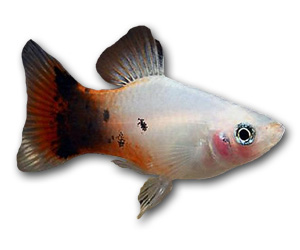Platy

Quick Stats
| Size | Up to 2" (5cm), females larger |
|---|---|
| Tank | 40 litres and above |
| Swimming Area | Middle. |
| Ph | 7.0 to 8.3 |
| Temperature | 68ºF to 79ºF (20-26°C) |
| Food | Flakes and Bloodworm |
Common Name:
Platy
Distribution:
Wide spread throughout Central America from Mexico to Guatemala.
Colouration:
The original wild form was a plain grayish brown to olive color, showing a slight sparkle. There were also salt and pepper markings scattered over the body. The many wild varieties have been crossbred and combined so often, the range of colors and fin shapes is almost unlimited with variations showing up almost on a monthly basis. Varieties that have remained popular in the hobby include the Red-Wag-tail Platy, Tuxedo Platy and many variations on the high fin theme.
Lifespan:
3 to 5 years.
Maintenance:
10% weekly water changes. An easily cared for fish that does well in all types of community aquaria. Although not a schooling fish they benefit by being kept with a large number of their own kind. Avoid driftwood as swordtails do not like acidic water.
Feeding:
In addition to live and flake food their diet should be supplemented with some plant material.
Substrate:
A sandy bottom is best.
Tank Decor:
Give them a fairly large tank with live plants and open swimming areas, avoid too much driftwood as a rule the livebearers do not like acidic water.
Filtration:
Filter suitable to the size of tank in which they are housed.
Biotype:
Rivers in Mexico and Guatemala.
Breeding:
As the male matures the Anal fin develops into a structure for reproduction called the Gonopodium. The Gonopodium can be moved in almost any direction and stores the sperm in packs called spermatophores. Once the sperm is inserted into the female it fertilizers her eggs and the rest is stored in the Oviduct walls for later use. The eggs are very rich in yolk and the young develop by consuming their yolk stores. In light colored females pregnancy can be recognized by the growing dark body marking in front of the Anal fin. Young Livebearers are fairly large at birth and their development is very advanced. They can swim right away, which is needed to avoid their enemies including their parents who give no natal care whatsoever. The fry grow very rapidly and will eagerly accept fine flake food. An interesting fact on Swordtails is their ability to change sexes. All young swordtails are female and if a potential male starts to develop early, he will continue to become a slender small male. If a potential male goes through a female stage complete with the typical female form and gravid spot, he will develop into a large thickset "late" male.